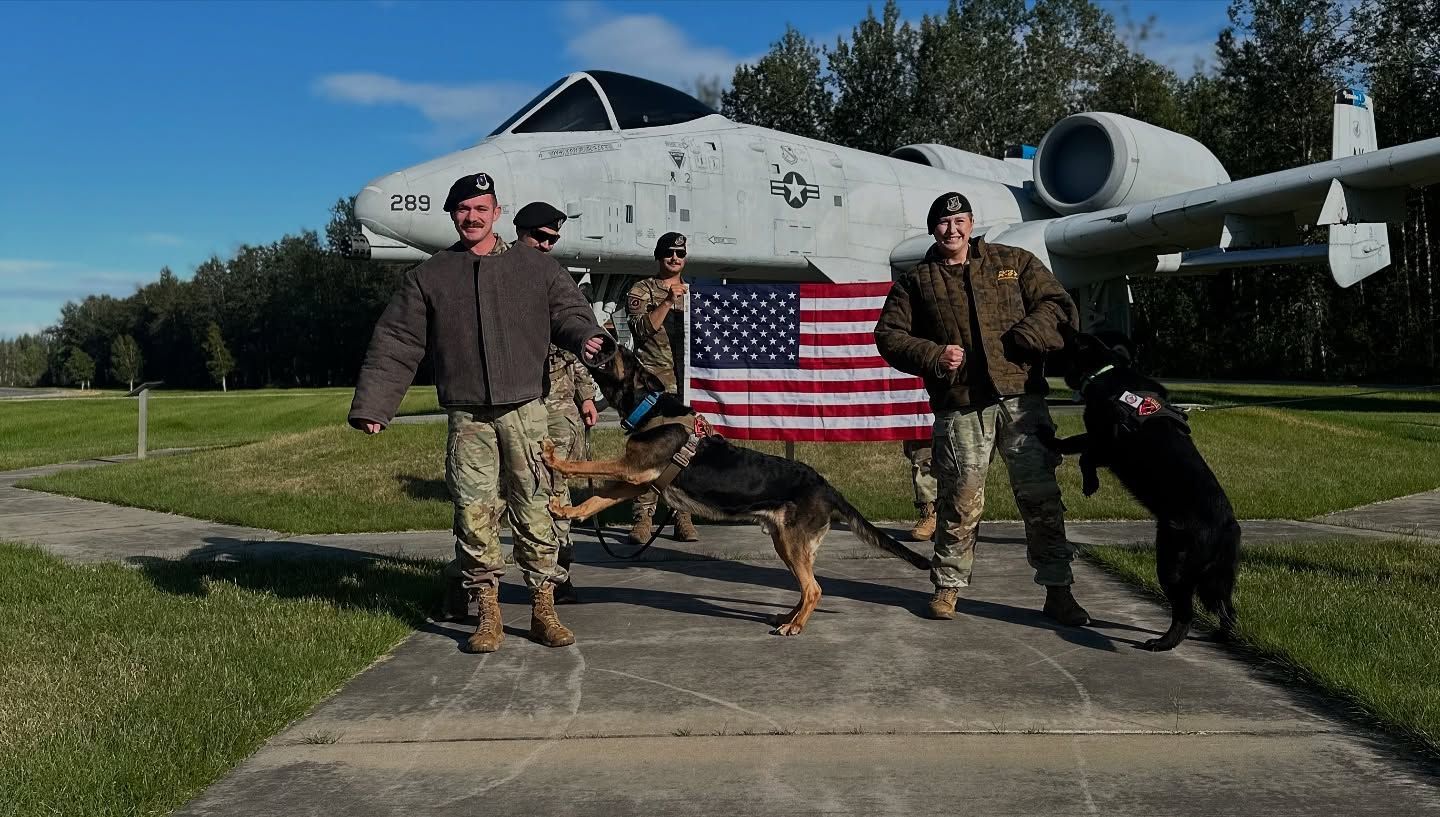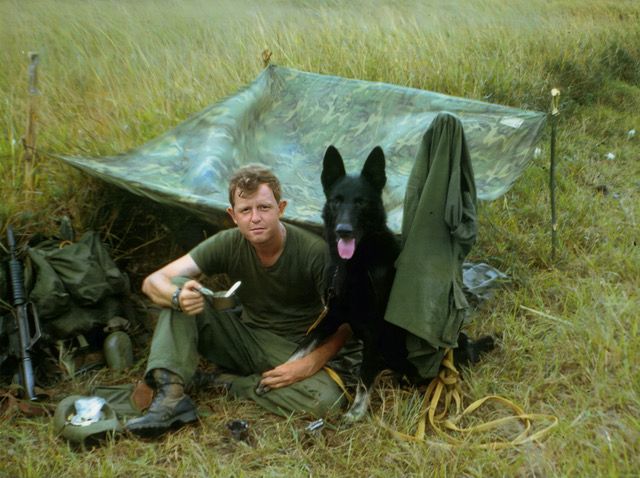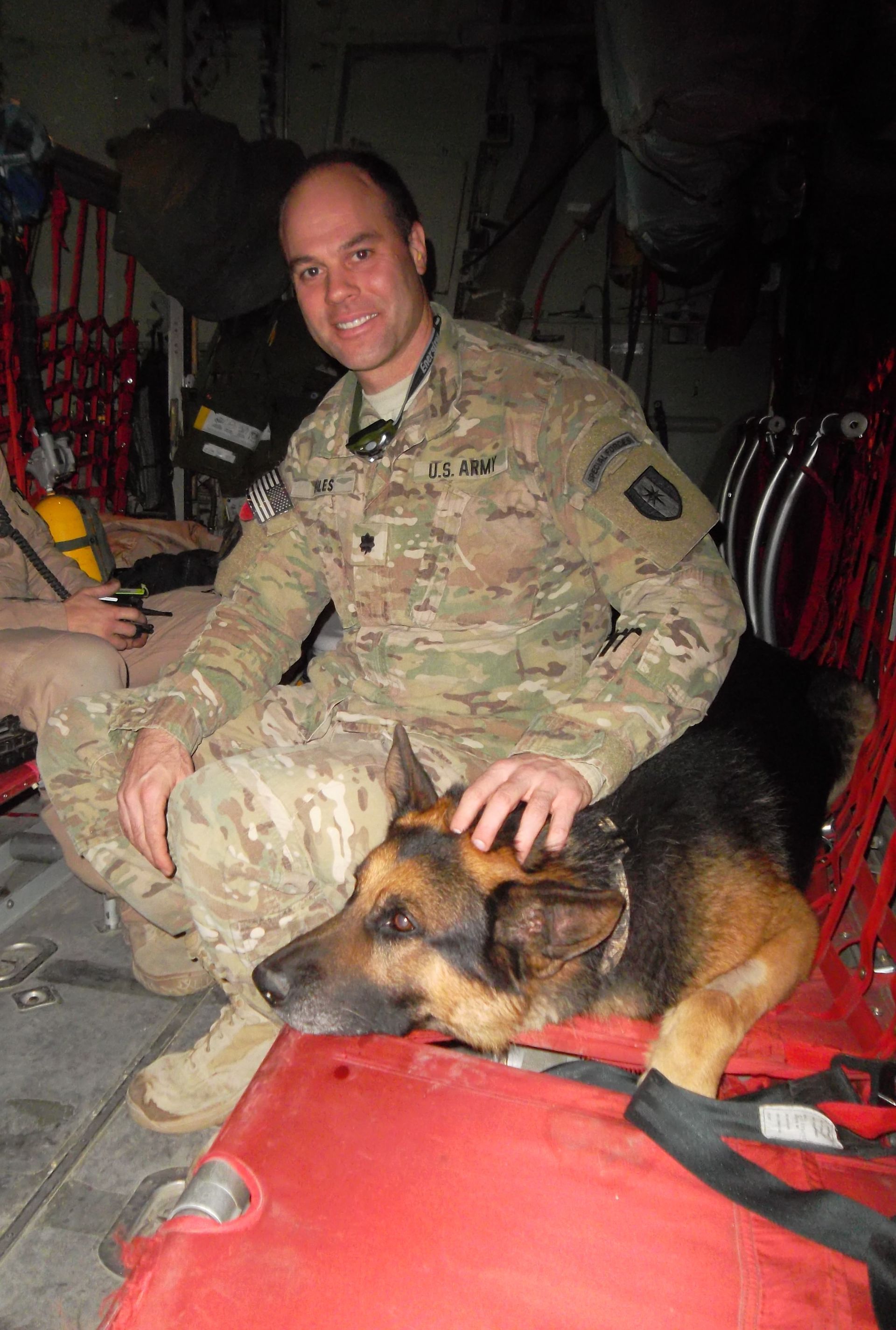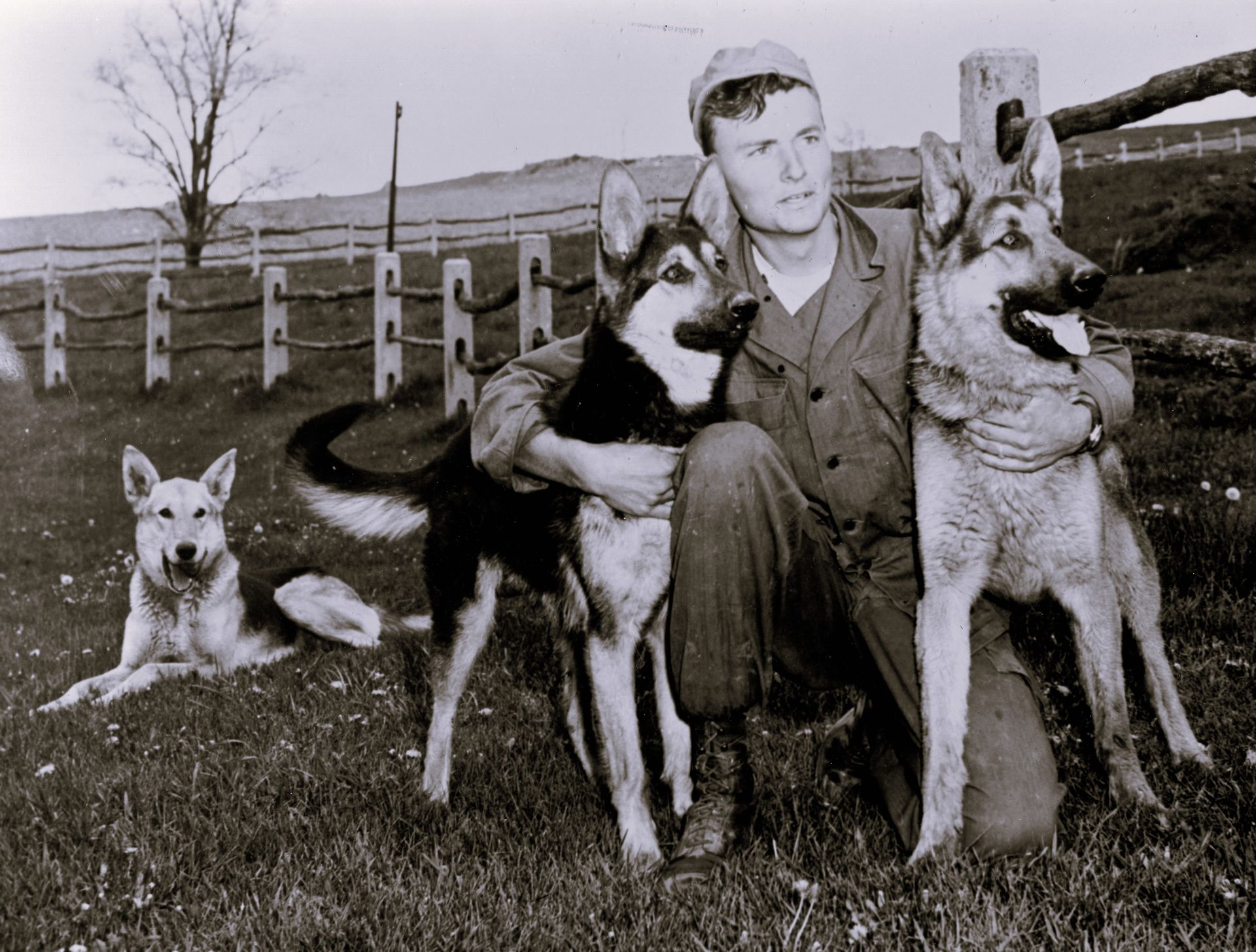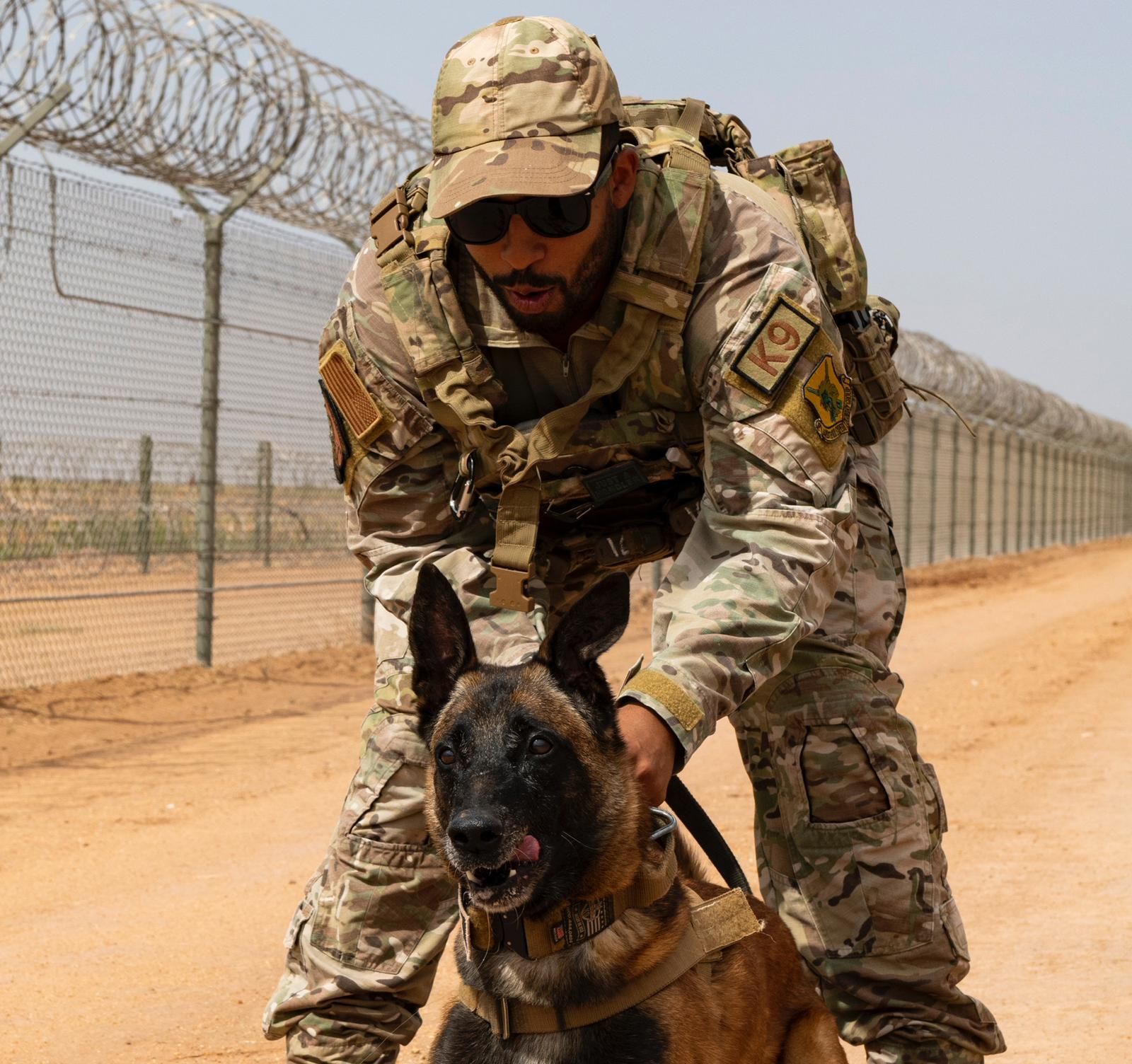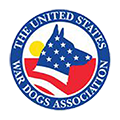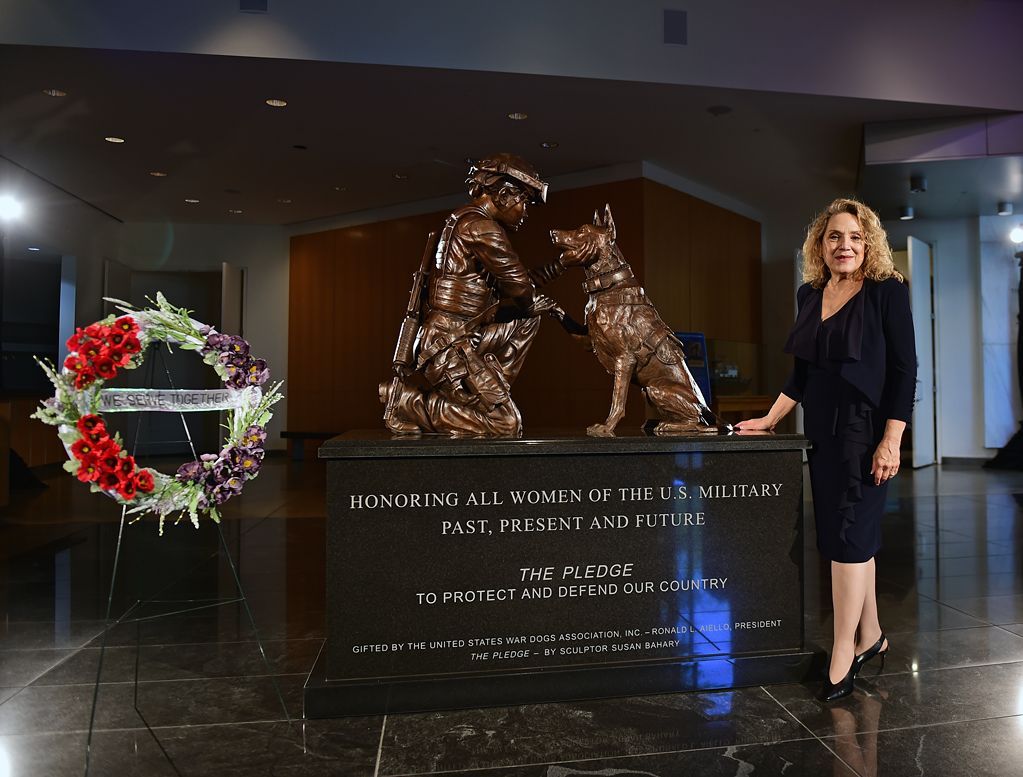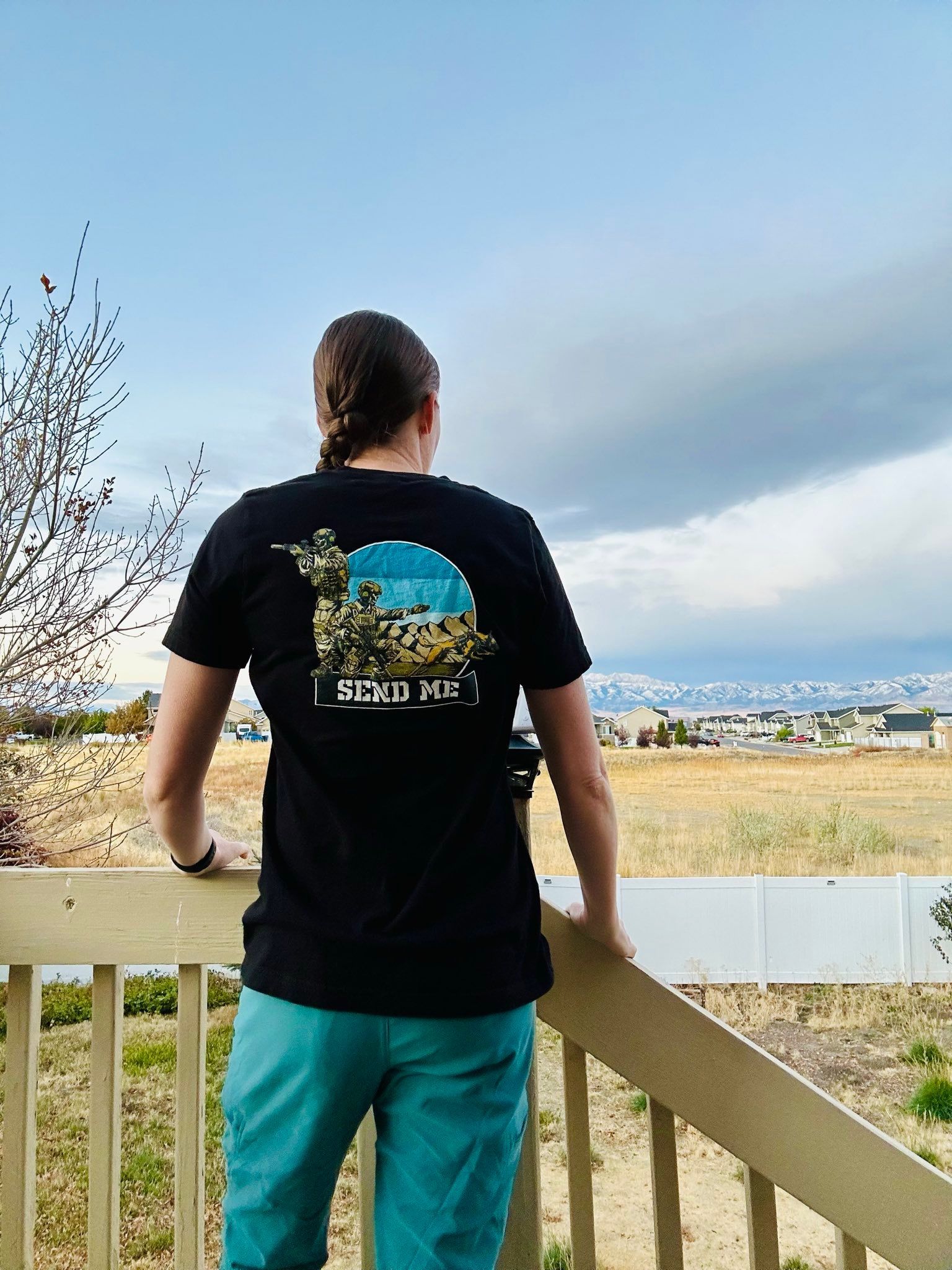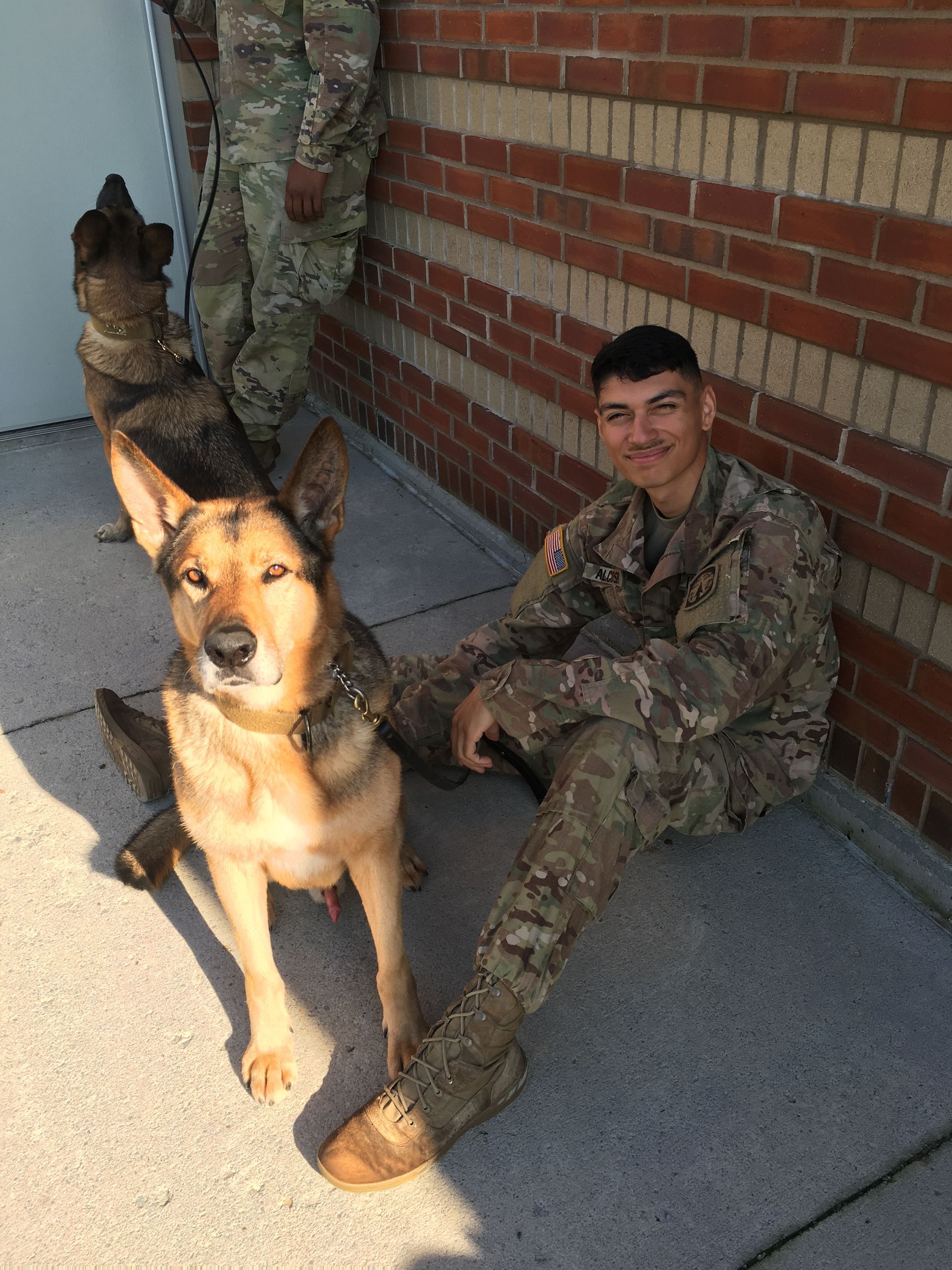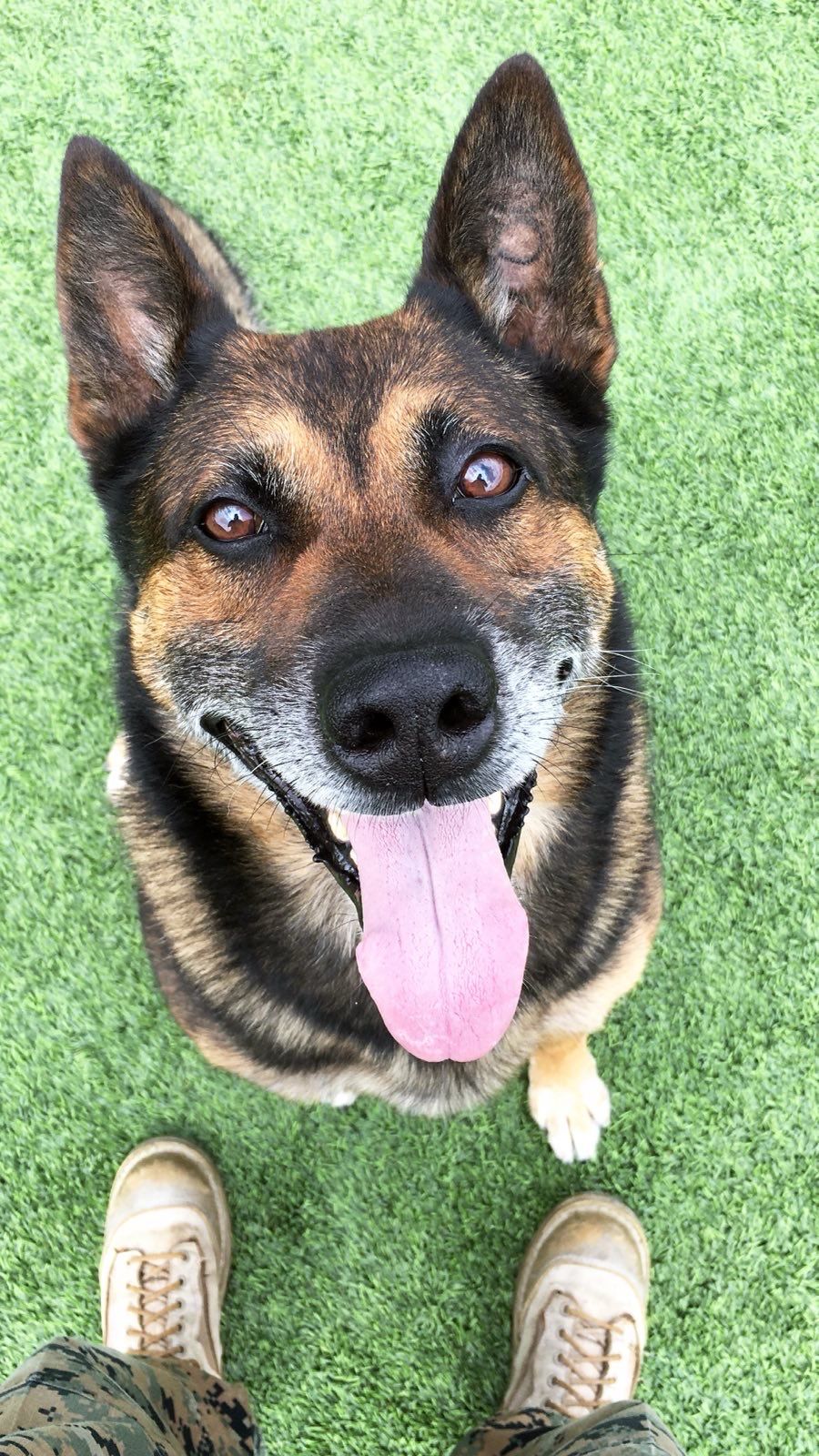
War Dogs Team Member Highlight: Aaron Stice
Our team of volunteers at US War Dogs aren’t just helping to keep the wheels of our incredible organization turning. They bring a tremendous amount of personal experience from their years in K-9. We’re thrilled to spotlight our volunteer, US War Dogs care coordinator and former US Marine Corps dog handler, Aaron Stice, to talk about his career in K-9, some of his core memories as a dog handler and why he decided to give up a portion of his valuable spare time to support our mission.
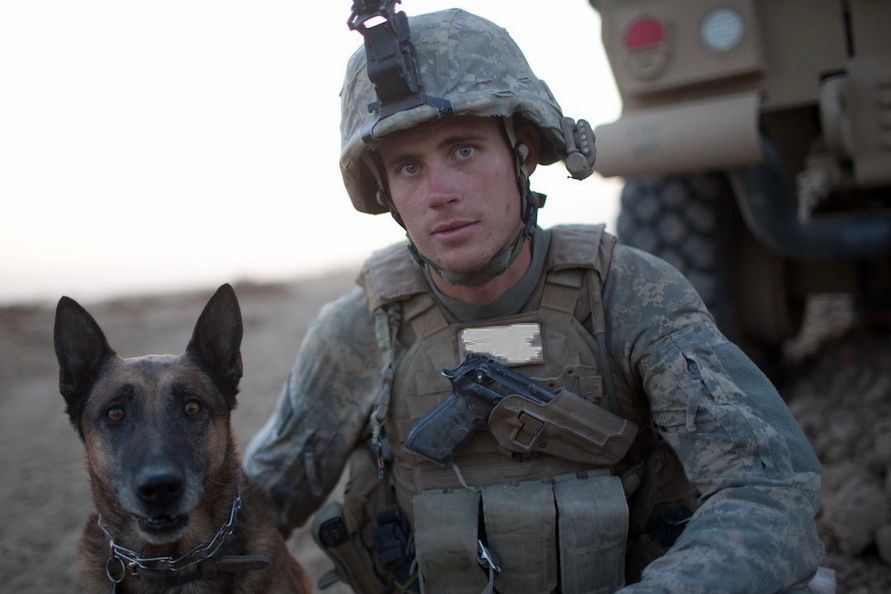
US War Dogs care co-ordinator, Aaron Stice
Aaron Stice was 21 years old when he signed up to join the Marine Corps. Inspired by his stepdad, who spent two years as an armourer in the Corps, Aaron had spent his high school and college years footloose and enjoying some carefree times. “College was a party for me. I messed around and didn’t have any ideas about what I might do with my life until some heart-to-hearts with my stepdad made me seriously consider a career in the military.”
Aaron hailed from Texas and as a West Coast Marine, attended bootcamp a MCRD San Diego in 2007 before completing Marine Combat Training at Camp Pendleton, CA, and enlisting as a military police officer (MPO). While Aaron was at MP School at Fort Leonard Wood, MI, he discovered the MWD program. “K-9 kind of fell into my lap. I had always been an animal lover but K-9 wasn’t in my field of vision at all, so when I was offered the chance to try out, I jumped at it.
“The wars in Iraq and Afghanistan were raging so there was a need to keep new dog handlers coming. I was pipelined across to the program and after graduating MP school out of Fort Leonard Wood, went to Lackland Air Force Base for K-9 training.”
As a novice K-9 handler, Stice was quickly exposed to the peculiarities and gifts of the role. “Seeing what these dogs were capable of and feeling the bond building – even with the demo dogs – blew me away.”
After completing the basic handlers’ course, Stice was pipelined across to specialized search dog (SSD) training, responding to the need that was being dictated by the style of combat that troops were facing overseas. “I was asked to move across to SSD and didn’t think twice about it. I knew that I needed to be ready to respond to the threats our troops were facing, so if this was it, I was all in.
“My knowledge of the program was pretty limited. All I knew is that you trained and deployed with the same dog, which contrasted with the way that basic training was structured.”
Stice was paired with a TSA breeding program yellow labrador called Wwelty, who had enjoyed a unique start in life. “Wwelty had been raised in a prison as part of a program to help rehabilitate inmates, which was a pretty unique start in life. We gelled well and transitioned to Camp Pendleton together, but our time as a dog team was short-lived and after six months, Wwelty was moved out of the program, which left me open to take on a new dog.”
Johnny
Stice was paired up with a seasoned Malinois and renowned asshole, Johnny. “He’d completed four combat deployments and had a real reputation, so as a junior handler, I was pretty scared. Fellow Marine Corps dog handler Albert Johnson handled Johnny before me so was able to give me some good tips as we handed over. It took six months for me to lose my fear and build a rapport with Johnny.”
Stice learned quickly that Johnny had developed some serious issues with gunfire during his tours in Iraq and Afghanistan. “We were taken out on gunfire training and of course, I was dreading it as I knew Johnny wouldn’t have a good time. When it was our turn to step up in front of the guys, I pulled out my pistol and saw Johnny eyeballing it. As soon as I shot, he jumped in front of me and as I went to holster the gun, he wheeled round and bit me right in the ass, in front of everyone.
“It was the only time Johnny bit me, but it was pretty memorable, and so embarrassing.”
Record Deployment
Stice and his trainers worked hard to cure Johnny of his aversion to gunfire, which meant that he was mission ready when the call came for 30 dog teams to make the trip to Afghanistan in 2010.
“We had all trained hard together so the sense of brotherhood as we headed out was really strong. It felt good to be going on my first deployment with friends like Al Brenner. Chris Willingham (president of US War Dogs) was our kennel master and we were the largest cohort of dog teams to deploy to foreign soil since Vietnam, which felt like a big deal.”
The Marines flew into Camp Leatherneck and spent two weeks acclimating to their new environment in Helmand Province. The dog teams were then given their assignments, with Stice and Johnny attaching to a team of recon guys.
“At this point, I don’t know anything about war, so the guys I’m attached to explain what’s to come: A 14-day mission in the Afghan desert, searching for weapons and IEDs. We would set up compounds and searched for miles over the harsh and unforgiving terrain, with plenty of enemy gun fights to keep us on our toes. Resupply helicopters were vital to our survival out there. I would contact Chris to order up Johnny’s food and he would make sure that we had everything we needed.
“The mission ended up lasting 53 days which, for someone so junior, gave me a decent grounding in how things worked, particularly having spent that time with such a high-ranking team that were structured so differently to what I was used to.”
Following Stice’s first couple of months in Helmand, he and Johnny were then sent to Kandahar to support the Army, along with many of the Marine dog teams from Camp Pendleton.
“Johnny and I went to FOB Wilson before being sent to the tiny FOB Howz-e-Madad. It was complete hell. Chris came to visit us to see where we were and saw how dire it was. As kennel master, his role was to make sure that all the teams had everything they needed, as well as coordinating the supply of dog teams where they were required. Chris didn’t need to get out and see us like that, or go outside of the wire with us, but he made a point to visit each of us and shadow us on at least one combat mission.
“It meant the world to me and the other guys to have that support from him and it really stood him out as a leader.”
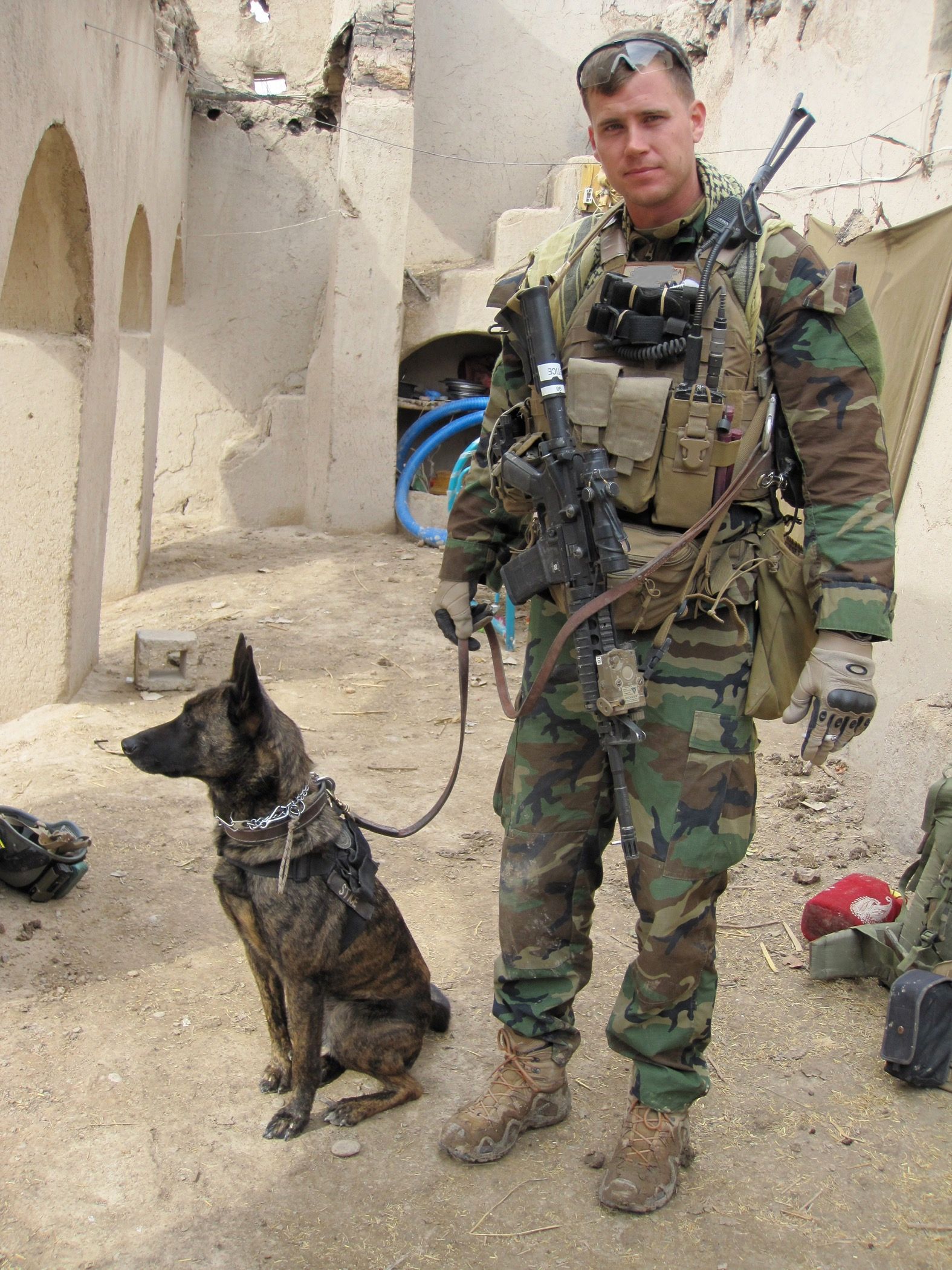
Stice and Maika
First Find
While Stice and Johnny worked in the dangerous and frenetic areas in and around Kandahar, their exposure to the realities of war continued in earnest. “We were running three or five-day missions – many of which were helo insert situations, so it was very busy.
“By this point, we were a couple of months into the deployment and Johnny hadn’t found anything. I’ll be honest, I was beginning to wonder whether I was doing this right but I didn’t have much longer to wait before Johnny showed me the goods.
“We were searching a tree line next to a dried-out creek when Johnny jumped down into the waterless creek and stopped suddenly. He turned and just stared at me for a few seconds, so I told him to lay down so I could search the area with my scope. I could see a piece of yellow tape and some disturbed earth near to where he was. We called EOD, who detonated what Johnny had found, which turned out to be an IED containing 50lbs of explosives, pressure plate and mortar round.
“Johnny saved multiple lives that day and really showed me and the other guys in our platoon what he could do. It really changed the game for us.”
Johnny’s first find opened the floodgates for the dog team, who continued to find weapons caches and IEDs on roadways. “All the training we had done really came to fruition. It really blew my mind, seeing what he could do, and it deepened my bond with Johnny. When I got back from that mission, the first thing I did was email Albert Johnson to tell him that Johnny had saved my life.”
This deployment would be Johnny’s last and when the teams arrived home, Al Johnson adopted Johnny, who lived out his retirement with Al’s family in Tennessee. Stice recalls: “Al is a close friend so I received regular updates on how Johnny was doing. When he got sick and passed away, I went to Tennessee to spend a few days with Al and he held a beautiful memorial for Johnny.
“I feel very grateful for the time I spent with him, especially after he saved my life on so many occasions.”
Marky Mark
Despite there being numerous terrifying moments on that deployment, rare pockets of lightness were afforded the troops, with one such moment provided by a world-famous visitor. Stice recalls the day that Mark Wahlberg came to visit the dog teams in Afghanistan, as part of a USO tour for his movie, The Fighter.
“Chris had chosen me and Johnny to do a basic demo for Mark which, for a highly trained and combat-experienced dog, should have been a piece of cake. But Johnny had already proved to have great comedy timing at my expense, and when I opened his kennel to enter the training area, he ran at full speed, straight at Mark Wahlberg, headbutting him in the nuts and causing his security to scramble to his aid. It was a real ‘oh shit’ moment.”
The moments of fun were contrasted greatly by the loss of brothers – injured or killed in combat – during those turbulent and violent times. “We all took the death of Max Donohue hard. We had deployed as a tight unit of friends that had trained together and were taking on this mission together. Our brother Al Brenner, was also seriously hurt and his dog, Grief, killed out there. We all bare the emotional scars and those feelings unite us in sorrow and a resolve to uphold the legacy of that deployment.”
Following Stice’s return to the US the day after Christmas in 2010, the remaining months of his military career hung in the balance. “I was due out in 2012 and with a required 12 months’ dwell time at home before anyone could deploy again, I didn’t expect to return to Afghanistan. But, the need for experienced dog teams was as strong as ever and it was agreed that I would return with the first Marine Expeditionary Force (1 MEF) with 30 dog teams.
“This deployment was very different for me as now I was the senior guy who needed to support and lead the young handlers. Now, I’m the one setting up training and passing the dogs after their acclimation time. It adds a new pressure and it’s so easy to question yourself because now they’re going out and running missions on my say-so.”
Stice and his new dog, Maika, were assigned to MARSOC. “By now, I knew the plan. With Special Ops, we’re running in smaller teams with different uniforms. Our cohort was made up of five Americans and 30 Afghans, which changed the dynamic.

Johnny and Stice on deployment
“Our job with MARSOC was to insert into areas where they weren’t expecting us, so although Maika was great at her job, we didn’t rack up any finds as there were no IED threats on my missions. The objective was to get in, disrupt, get into some gun fights and get out.”
Stice’s new dog – a small female Dutch Shepherd – brought a new aura to bare. “She was such a sweet girl and would let anyone take her for a walk… very different to Johnny. She really didn’t get to spread her wings, given what was required of us.”
This deployment would bring with it fresh heartache for Stice. “Keaton Coffey was part of the MARSOC team Maika and I were attached to. He was a great Marine and a fantastic dog handler. He had combat experience prior to our deployment but not with K-9, so he was a junior handler when we deployed with his dog, Denny.
“The MARSOC guys called and asked for a patrol dog to support them so Coffey was sent out. He meshed well with the team and before he went out, I was able to catch him up to speed with the extra gear that Special Ops worked at and some of the peculiarities of how the team operated.
“Being out on that mission when Keaton was killed was a huge shock. When it came over the radio that it was an American that was down, we worked out that it was Keaton. But while we were in the thick of things, there was no time to deal with it – especially as we were in a live fire fight.”
Returning home with two deployments under his belt and the mental scars that come with them, Stice had a big decision to make. “I was on the fence about getting out. I had done five years but I had been away from home a lot. I’d gotten married and decided that it was time to settle down.”
Life After the Corps
Following his honorable discharge, Stice moved to his wife Sandi’s native city of Chicago. “I wanted to give Sandi some time to enjoy familiar territory near her family again, after chasing me around the country. I enrolled at Roosevelt University to get my Batchelor’s degree in Criminal Justice, having always had an interest in law enforcement. But it was tough. Coming out of the military and moving somewhere new was hard. I was at a school with kids in their early 20s, living it up and enjoying college life. I was only 27 at this point but my approach to schooling was completely different to my classmates. I was always 30 minutes early and built up a great friendship with my lecturer, who I found real common ground with.”
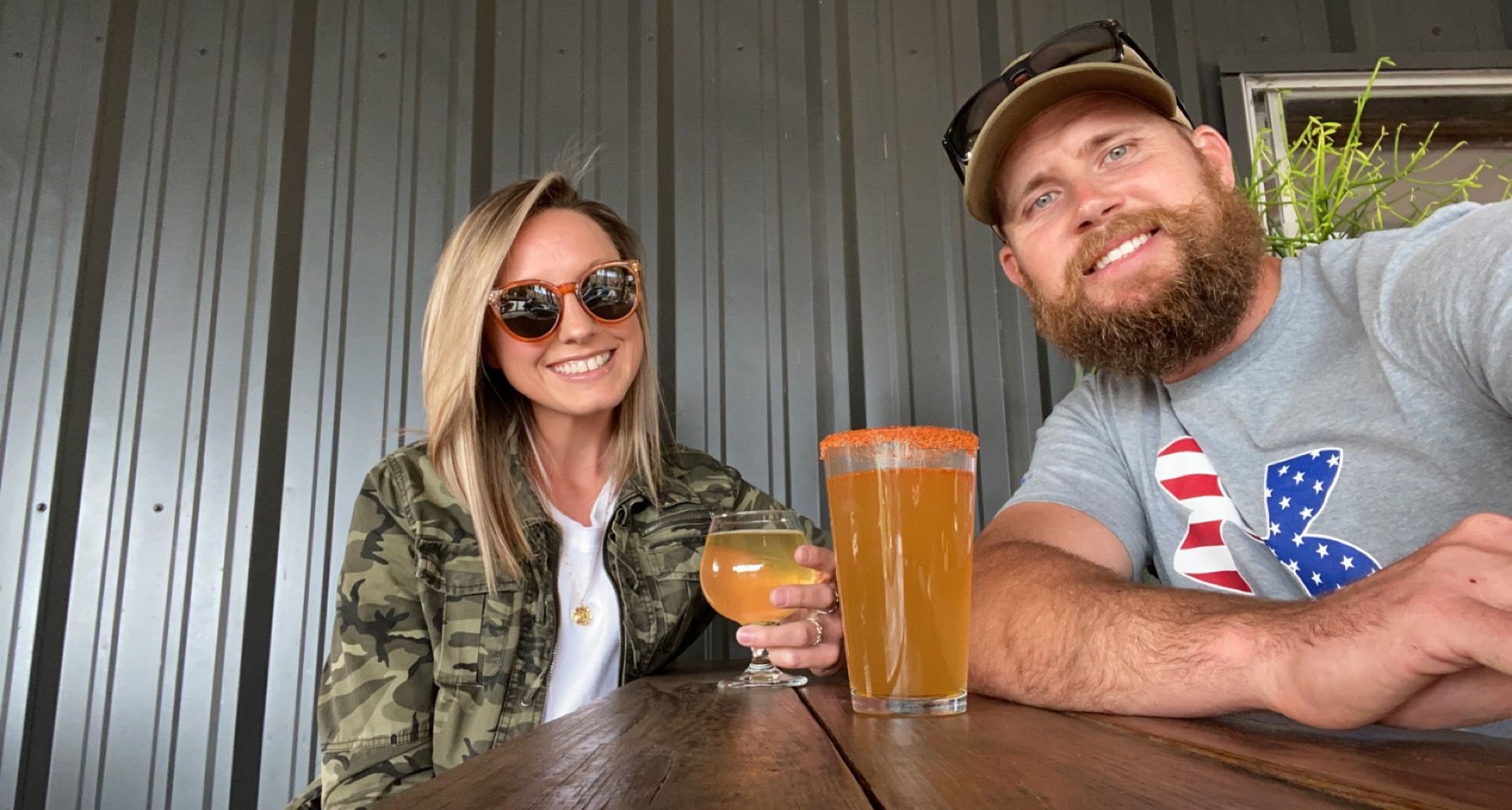
Stice and his wife, Sandi
As well as studying, Stice worked part time for TSA, checking luggage at the airport. “I wanted to get onto TSA’s K-9 program, but it is extremely competitive. I started looking at working for Customs but nothing ever panned out. I was feeling pretty hopeless and then a buddy called me and said there were law enforcement jobs at Miramar, San Diego. We missed the weather in Cali so I applied and was offered a position, which eventually lead to a job as a civilian police K-9 officer at Camp Pendleton.”
Returning to life as an operational K-9 handler suited Stice perfectly and meant that he was able to enjoy the bond with a working dog again. “I went over there to be handler but was also the chief trainer, teaching detection and bite work.”
Kkeaton
The twists, turns and coincidences of life in K-9 were about to hit Stice afresh, as he turned up to receive his first dog. “The kennel master said that there were two dogs open, but that both had problems. The first was Rocky. The second was Kkeaton – named after a fellow K-9 handler – turned out that Keaton was killed on 24 May 2012 and that Kkeaton was born on 27 May 2012… the breeding program puppies just happened to be on ‘KK’, so it made perfect sense to name one of the pups after our fallen K-9 brother.
“Nobody could work him but I had to take him. Kkeaton was trained at Lackland and went to the Air Force, but he was too much dog for them, so they sent him to the Marines, who have a reputation for taking problem dogs.
“Kkeaton had been at PMO Kennels but nobody had done anything with him. He was 100lb of dog and super intimidating. He would bear hug you to stop you from leaving his kennel. He had gunfire issues too… he ripped my pant leg off in training, so we had some fun. But we settled down and built that bond, which ended up being unbreakable.”
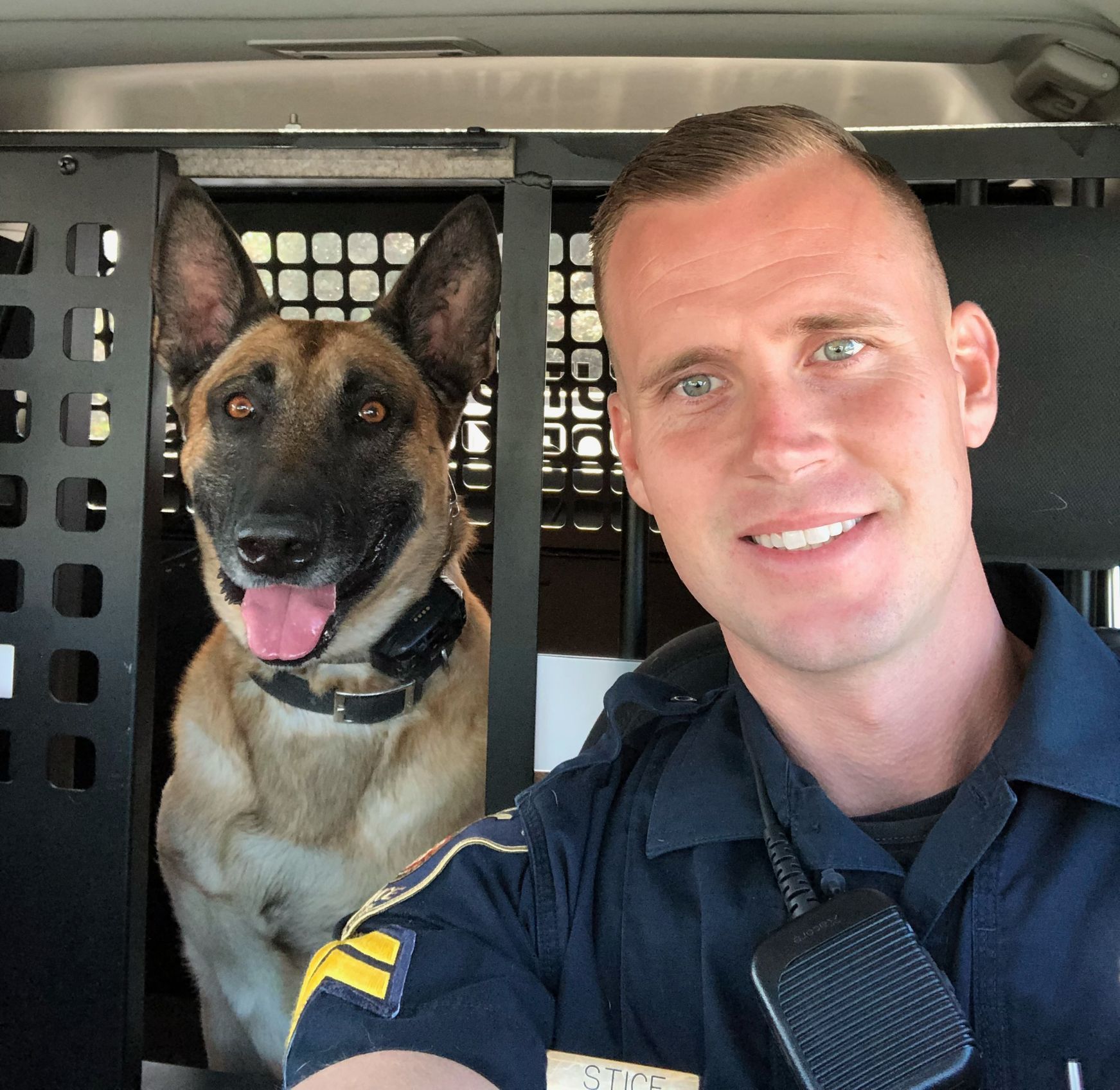
Kkeaton and Stice on duty
Stice worked his civilian K-9 role in San Diego for 2.5 years, before moving over to a role training dogs at DTS, Lackland Air Force Base. “I loved dogs and knew that I wanted to carry on working with them, although I knew I needed a change. Of course, it was a huge wrench to leave Kkeaton behind, as he was still of working age. We tried to work some deals to get him out with me because he couldn’t work with anyone else. After three months of being in TX, the team from San Diego called me and said he had a problem with his neck that meant he needed to be medically retired. I adopted him in May 2019.”
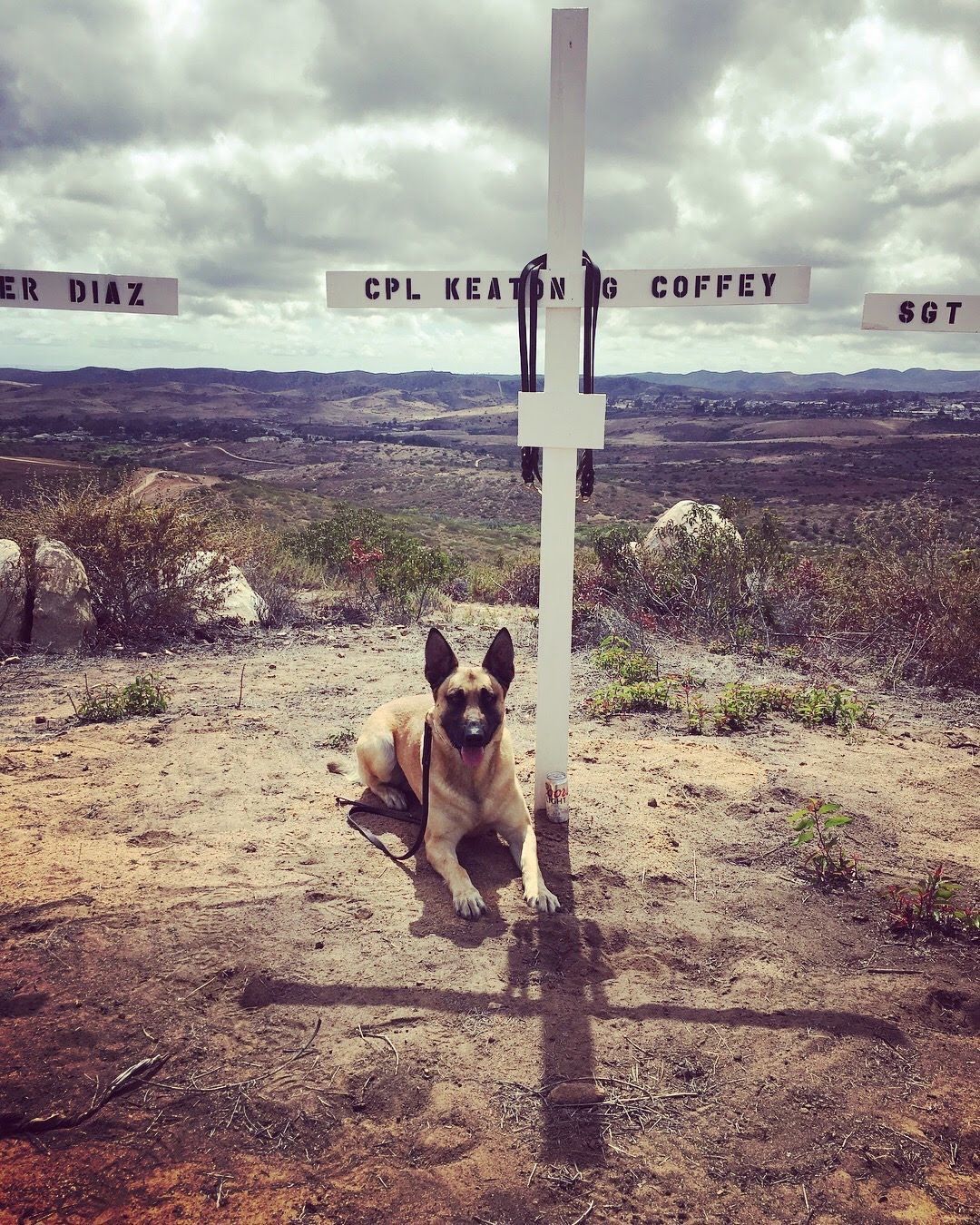
Kkeaton visiting the Memorial Crosses at Camp Pendlton, honoring fallen handler Keaton Coffey
Retiring Kkeaton caused some trepidation for Stice, who had witnessed his beloved working dog shred a hotel room while supporting Secret Service missions. “He was a Tasmanian Devil, trying to eat my pillows and wrestle me. I was a little worried as to how he would adjust to life in a family home.”
Kkeaton would also be living with Stice’s personal dogs: His pet Malinois and a little herding dog, who set her stall out with him immediately and became the boss of the pack. “I needn’t have worried. The three dogs slept in between us at night. Kkeaton went from being a seasoned war fighter to a teddy bear, virtually overnight.”
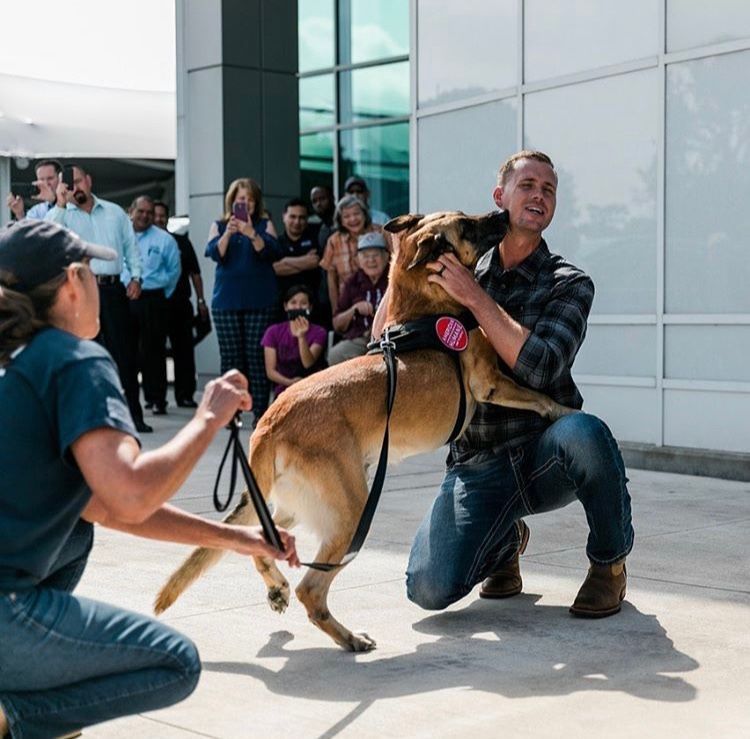
Reunited: Kkeaton on the day he retired with Stice and Sandi
Stice loved being back at Lackland and relished the challenge of training the green dogs. But secretly, he had his sights set on working at the breeding program, so when a position came up nine months after his move to DTS, he jumped at it. “Breeding puppies for the military ended up being my ultimate dream. It’s a very physical job but I want to do it for as long as I can. There are only three trainers compared to so many dog. We are working with seven- to 12-month-old pups, so you can imagine the chaos. But it’s our job to pull out their drives and teach them to search before they go into DTS.”
Kkeaton benefited from Stice’s job at Lackland too. “He loved coming to work with me. I’d let him find explosives and relive his glory days. He had a fantastic retirement with us. Eventually, his neck trouble worsened to a point where he couldn’t look left or right. He passed away in 2022 and if I’m honest, I am still not over it.”
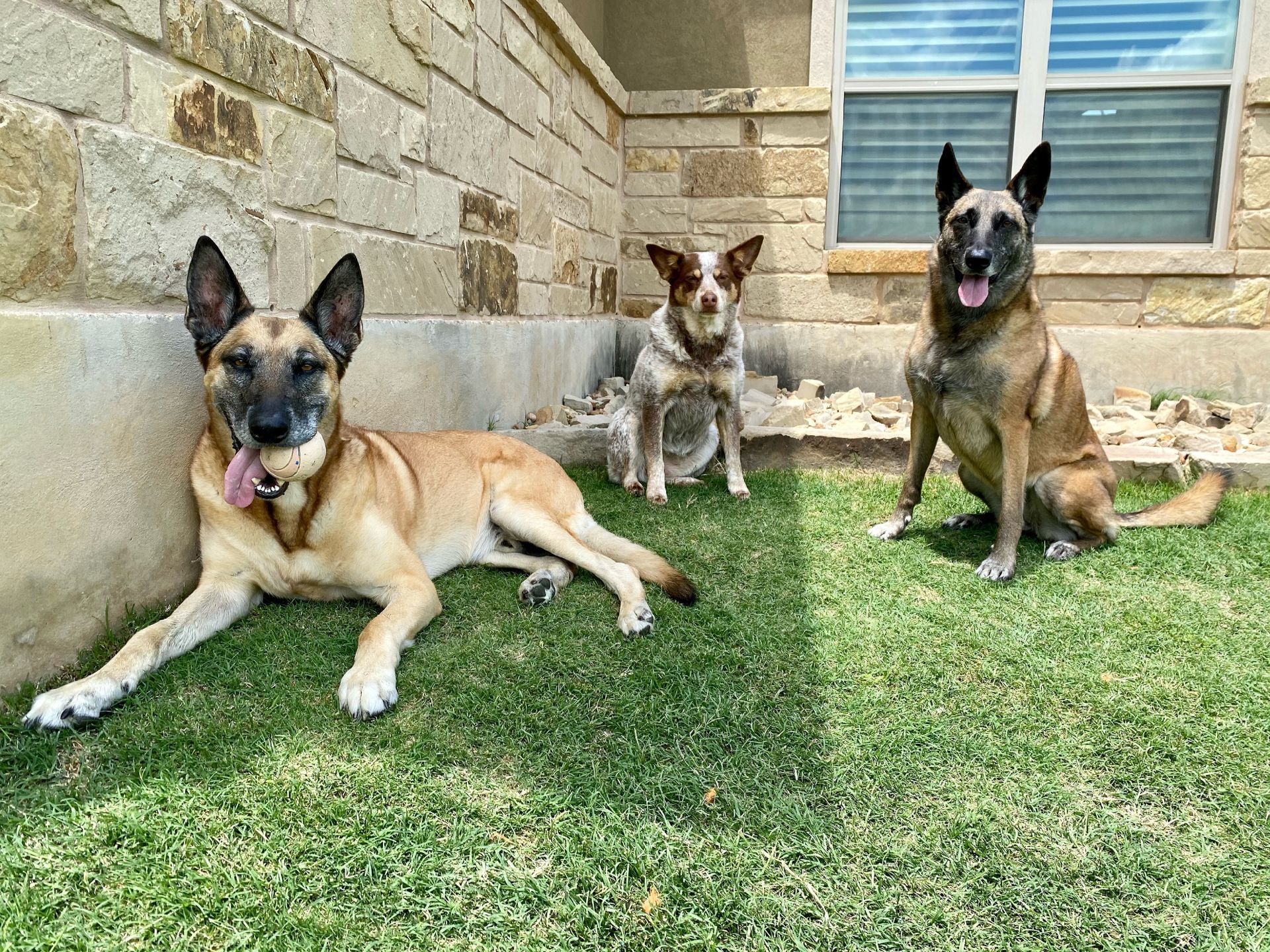
Kkeaton with Stice and Sandi’s other dogs, Mocha and Kona
Repping For War Dogs
After Kkeaton passed away, Stice felt like he wanted to do something to give back to the community. He said: “I am passionate about K-9 and benefitted from War Dogs while deployed, receiving care packages from the organization, so I decided to reach out to Chris and offer my help.
“Chris was a great mentor and leader in combat and has since become a close friend, so it felt right to offer my support to him.”
Aaron is now an integral part of US War Dogs’ service delivery – ensuring that all newly retired MWDs are registered to receive support through our Rx Program.
“Staying connected to K-9 in my career has been a great source of comfort and satisfaction for me and know that I am giving back to MWDs who have given their best years in service to our country, is a source of great pride.”
